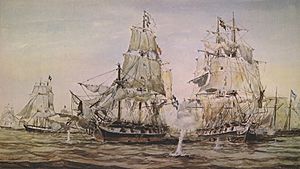Battle of Quilmes facts for kids
Quick facts for kids Battle of Quilmes |
|||||||
|---|---|---|---|---|---|---|---|
| Part of the Cisplatine War | |||||||
 |
|||||||
|
|||||||
| Belligerents | |||||||
| Commanders and leaders | |||||||
| Strength | |||||||
| Total guns: 208 | Total guns: 138 | ||||||
| Casualties and losses | |||||||
| No ships lost 6 killed 24 wounded |
1 frigate sunk 30-100 killed 70-100 wounded |
||||||
The Battle of Quilmes was a naval fight that happened between the navy of the Empire of Brazil and the navy of the United Provinces of the Río de la Plata. It took place near Quilmes, Argentina, on July 29 and 30, 1826. The Brazilian fleet was led by Admiral James Norton, and the Argentine fleet was led by Admiral William Brown. This battle was part of the Cisplatine War, a conflict over control of a region called Cisplatina (today's Uruguay).
Contents
What Led to the Battle
On the night of July 29, 1826, an Argentine group of ships was moving soldiers and military supplies across the water to the Banda Oriental (an area on the eastern side of the Río de la Plata). This group was protected by a small ship called the Río de la Plata schooner.
At the same time, Admiral Brown, with his main Argentine fleet, was waiting for this group to arrive. His fleet included his biggest ship, the 25 de Mayo frigate, along with several other ships like brigs and schooners. He tried to surprise the Brazilian fleet, but it didn't work.
The Brazilian fleet, led by Captain Norton, was much larger. It had many ships, including the Nichteroy frigate, several corvettes, brigs, and schooners. They had over 200 cannons in total. The Brazilians waited near the coast of Quilmes, planning to attack the Argentine ships as they returned.
Ships in the Battle
Here are the ships that fought in the Battle of Quilmes:
Brazilian Ships
| Ship Name | Type of Ship | Number of Cannons |
|---|---|---|
| Nichteroy | Frigate | 38 |
| Maria da Glória | Corvette | 30 |
| Liberal | Corvette | 22 |
| Maceió | Corvette | 20 |
| Itaparica | Corvette | 20 |
| Caboclo | Brig | 18 |
| 29 de Agosto | Brig | 18 |
| Pirajá | Brig | 18 |
| Leal Paulistana | Schooner | 8 |
| Conceição | Schooner | 4 |
| Dona Paula | Schooner | 4 |
| 7 de Março | Schooner | 3 |
| 9 de Janeiro | Gunboat | 2 |
| 12 de Outubro | Gunboat | 2 |
| Itaparica | Gunboat | 1 |
Argentine Ships
| Ship Name | Type of Ship | Number of Cannons |
|---|---|---|
| 25 de Mayo | Frigate | 36 |
| Independencia | Brig | 22 |
| Congreso | Brig | 18 |
| Republica | Brig | 16 |
| Balcarce | Brig | 14 |
| Oriental-Argentino | Brig | 13 |
| Sarandí | Schooner | 8 |
| Río | Schooner | 1 |
| Pepa | Schooner | 1 |
| 9 Gunboats | Gunboat | 1 gun each |
The Battle
The fighting started on the morning of July 30. Admiral Brown, with his 18 ships, tried to surprise the Brazilians again, but it didn't work.
When the Argentine ships got close to the Brazilians, Captain Norton split his fleet. This meant the Argentine ships were caught between two groups of Brazilian ships, getting attacked from both sides. Admiral Brown, on his ship the 25 de Mayo, had to turn around.
The Argentine ships at the front of their line faced very heavy cannon fire. After about three hours of intense fighting, the Argentine fleet managed to escape into shallow water. This was a smart move because the larger Brazilian ships couldn't follow them into the shallow areas without getting stuck.
Admiral Brown's ship, the 25 de Mayo, was badly damaged. It was like a floating wreck. It had to be pulled to a place called Los Pozos, where it later sank during a strong storm.
The Brazilians had 6 sailors killed and 24 wounded. One of the wounded was John Pascoe Grenfell, who lost an arm. The Argentine side suffered more losses, with an estimated 30 to 100 sailors killed and 70 to 100 wounded. Even though the Argentine fleet escaped, the battle was considered a victory for Brazil because of the damage they caused, especially sinking the 25 de Mayo.
See also
 In Spanish: Combate de Quilmes para niños
In Spanish: Combate de Quilmes para niños
Images for kids





